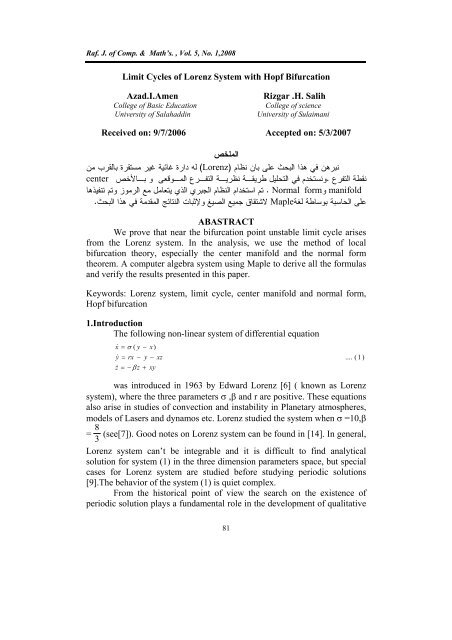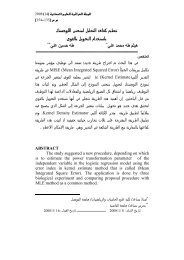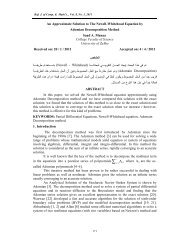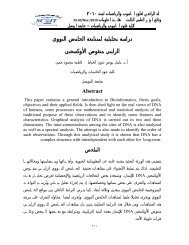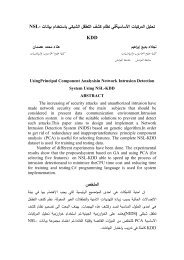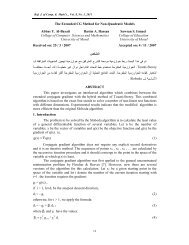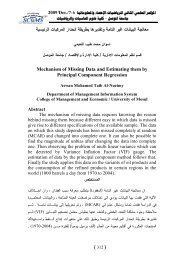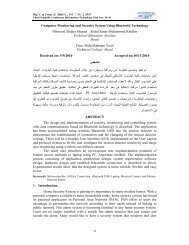Limit Cycles of Lorenz System with Hopf Bifurcation Azad.I.Amen ...
Limit Cycles of Lorenz System with Hopf Bifurcation Azad.I.Amen ...
Limit Cycles of Lorenz System with Hopf Bifurcation Azad.I.Amen ...
Create successful ePaper yourself
Turn your PDF publications into a flip-book with our unique Google optimized e-Paper software.
Raf. J. <strong>of</strong> Comp. & Math’s. , Vol. 5, No. 1,2008<strong>Limit</strong> <strong>Cycles</strong> <strong>of</strong> <strong>Lorenz</strong> <strong>System</strong> <strong>with</strong> <strong>Hopf</strong> <strong>Bifurcation</strong><strong>Azad</strong>.I.<strong>Amen</strong>College <strong>of</strong> Basic EducationUniversity <strong>of</strong> SalahaddinRizgar .H. SalihCollege <strong>of</strong> scienceUniversity <strong>of</strong> SulaimaniReceived on: 9/7/2006 Accepted on: 5/3/2007الملخصنبرهن في هذا البحث على بان نظام له دارة غائية غير مستقرة بالقرب مننقطة التفرع .ونستخدم في التحليل طريقة نظرية التفرع الموقعى و بالأخصتم استخدام النظام الجبري الذي يتعامل مع الرموز وتم تنفيذهاعلى الحاسبة بوساطة لغةMaple لاشتقاق جميع الصيغ ولإثبات النتائج المقدمة في هذا البحث.center(<strong>Lorenz</strong>). Normal وform manifoldABASTRACTWe prove that near the bifurcation point unstable limit cycle arisesfrom the <strong>Lorenz</strong> system. In the analysis, we use the method <strong>of</strong> localbifurcation theory, especially the center manifold and the normal formtheorem. A computer algebra system using Maple to derive all the formulasand verify the results presented in this paper.Keywords: <strong>Lorenz</strong> system, limit cycle, center manifold and normal form,<strong>Hopf</strong> bifurcation1.IntroductionThe following non-linear system <strong>of</strong> differential equationx&= σ ( y − x )y&= rx − y − xzz&= − β z + xy.... ( 1 )was introduced in 1963 by Edward <strong>Lorenz</strong> [6] ( known as <strong>Lorenz</strong>system), where the three parameters σ ,β and r are positive. These equationsalso arise in studies <strong>of</strong> convection and instability in Planetary atmospheres,models <strong>of</strong> Lasers and dynamos etc. <strong>Lorenz</strong> studied the system when σ =10,β= 8 (see[7]). Good notes on <strong>Lorenz</strong> system can be found in [14]. In general,3<strong>Lorenz</strong> system can’t be integrable and it is difficult to find analyticalsolution for system (1) in the three dimension parameters space, but specialcases for <strong>Lorenz</strong> system are studied before studying periodic solutions[9].The behavior <strong>of</strong> the system (1) is quiet complex.From the historical point <strong>of</strong> view the search on the existence <strong>of</strong>periodic solution plays a fundamental role in the development <strong>of</strong> qualitative81
<strong>Azad</strong>.I.<strong>Amen</strong> and Rizgar .H. Salihstudy <strong>of</strong> dynamical system. There are many methods for locating theperiodic solution,for example the Poincare return map, Melnikov integral,degree theory and bifurcation theory. In this paper, we shall use <strong>Hopf</strong>bifurcation theorem for finding the limit cycle (isolated closed orbits) <strong>of</strong> the<strong>Lorenz</strong> system.The paper consists <strong>of</strong> four sections. In section two we start byrecalling the well know center manifold and normal form theorem for thegeneral equilibrium point. Section three gives a detailed analysis <strong>of</strong> the<strong>Hopf</strong> bifurcation, using the method <strong>of</strong> local bifurcation theory, especiallythe center manifold and normal form theorem, it is proved that unstablelimit cycle arisesd, also limit cycles corresponding to some special values <strong>of</strong>σ,β at the <strong>Hopf</strong> bifurcation point. The paper ends <strong>with</strong> a brief discussion <strong>of</strong>the results. All the results presented obtained and verified using Maple workstation ([3], [4], and [7]).2. Center Manifold and Normal Form Theorem.In this section, we make a brief summary <strong>of</strong> the techniques we usedto reduce the dimension <strong>of</strong> system (2) by center manifold theorem andnormal form theorem to simplify the flow in the center manifold (see[5] ,[11]).The theory <strong>of</strong> bifurcations <strong>of</strong> parameterized dynamical system iswell known. One consider a vector fieldx& = f µ (x) µ∈R, x∈ R n....... (2)Depending on a parameter µ the equilibrium <strong>of</strong> the vector field are thosexo,µo such thatf µo (xo)=0.Perhaps the most important property <strong>of</strong> equilibrium is its stability. Inthe first approximation, which is determined by stability <strong>of</strong> its liberalizedsystem around xo, µox& = D f µ 0 (xo) µo∈R, xo∈ R n....... (3)Where D f µ 0(xo) is the Jacobian matrix <strong>of</strong> f, if all the eignvalues <strong>of</strong>D f µ 0(xo) have negative real parts, the equilibrium point is asymptoticallystable. If at least one eignvalues has positive real part, then the equilibriumis unstable [10]. The topological character <strong>of</strong> the equilibrium can change ata equilibrium value <strong>of</strong> the parameter, perhaps two branches <strong>of</strong> equilibriumcross or a branch loses or gains stability. Such a state and parameter iscalled bifurcation point <strong>of</strong> the parameterized vector field. If a conjugatecomplex pair crosses the boundary <strong>of</strong> stability then this bifurcation is called<strong>Hopf</strong> bifurcation.82
<strong>Limit</strong> <strong>Cycles</strong> <strong>of</strong> <strong>Lorenz</strong> …Theorem1.(Center manifold theorem for flows) [5]rLet f be aC vector field on R n vanishing at the origin ( f ( 0) = 0 ) andlet A=Df(0). Divide the spectrum <strong>of</strong> A into three parts, σ , σ , σ <strong>with</strong>⎧ < 0 if⎪Re λ ⎨ = 0 if⎪⎩ > 0 ifλ ∈ σ ,λ ∈ σ ,λ ∈ σscu.Let the (generalized) eignspaces <strong>of</strong>σ , σ , and σ be E ,scuscus cu, E and E ,rrespectively. Then there exists C stable and unstable invariantsus ur−1manifoldsW and W tangent to E and E at 0 and aCcenter manifoldcW tangent toE cs u cat 0. The manifolds W , W , andW are invariant for theflow <strong>of</strong> f .The stable and unstable manifolds are unique because its invariant,cbut W needs not be since its center is manifold(see[ 2]).We know that the complete stability and qualitative behavior <strong>of</strong> anequilibrium point depends on the behavior <strong>of</strong> the dynamics on the centermanifold [2]. We first note that center, stable and unstable manifolds areinvariant under the O.D.E. Assume that the O.D.E arex& =cA x +1f (x, y, z)sy& = A y+ f2(x, y, z) ........ (4)uz& = A z + f3(x, y, z)Where A c s u, A and A on the blocks are in the canonical form whosediagonals contain the eignvalues <strong>with</strong> Reλ=0, Reλ0,respectively, (x, y, z) ∈ R c s uc× R × R , c = dim E since the system(4)has cceigenvalues <strong>with</strong> zero real part ( E is called the center eigenvector), s= dimsE and u = dim E u , f1, f2 and f3vanish along <strong>with</strong> their first partialderivatives at the origin.Let y = h1(x) be a stable manifold and z = h2(x) be unstablemanifold where x is on the center manifold then h1 ( x)and h2( x)satisfy thefollowing equations:csD h1 (x) [ A x + f 1 (x, h1 (x), h2 (x))] – A h 1 (x)- f2 (x, h1 (x), h2 (x)) =0cA x + f1 (x, h1 (x), h2 (x))] –And the dynamics on center manifold isD h 2 (x) [x& =cA x +1f (x, h1(x),2uA h 2 (x) – f3 (x, h1 (x), h2 (x)) =0 ........ (5)h (x)) .... (6)83
<strong>Azad</strong>.I.<strong>Amen</strong> and Rizgar .H. Salihbecause it’s the most physically interesting case (among them <strong>Lorenz</strong>system at the <strong>Hopf</strong> bifurcation), we assume that the unstable manifold isempty, in this case (4) becomes:cx& = A x + f1(x, y)sy& = A y+ f2(x, y) ...... (7)In this form E c ={(x, y), y=0} and E s = {(x, y), x =0}, notealso f (0,0 1) =D f 1(0,0)=0 and f2(0,0)=D f 2(0,0) = 0 .The local Center manifold theorem[2] states that :∞cThere exists aC , center manifold Wloc(0) = {(x, y): y=h(x), |x|1 as x → 0 then it follows that h(x)=φ(x)+o( x p ) as x → 0.This theorem tells us that we can approximate the center manifold toany degree <strong>of</strong> approximation by solving the N-equation to the same degree<strong>of</strong> approximation. A standard approach to analyzing the behavior <strong>of</strong> theparameterized ordinary differential equation (2) around a bifurcation point isto treat the parameter as an additional state variable <strong>with</strong> dynamics µ& = 0and to compute the center manifold <strong>of</strong> the extended dynamics through thebifurcation point and the dynamics restricted to this manifold [5]. The center84
<strong>Limit</strong> <strong>Cycles</strong> <strong>of</strong> <strong>Lorenz</strong> …manifold is an invariant manifold <strong>of</strong> the differential equation which istangent at the bifurcation to the eignspase <strong>of</strong> the neutrally stableeigenvectors. In practice, one does not compute the center manifold and itsdynamics exactly, in most cases <strong>of</strong> interest, an approximation <strong>of</strong> degree twoor three suffices.For simplifying the flow in the center manifold the normal formtheorem is used in order to remove all non necessary terms up to a certainorder while retaining the right qualitative behavior <strong>of</strong> the system at thebifurcation point. The result <strong>of</strong> this simplification is the so called normalform <strong>of</strong> the flow. Normal form theory has been widely used in the study <strong>of</strong>non linear vector field, in order to simplify the analysis <strong>of</strong> the originalsystem,it provides a convenient tool to transform a given system to anequivalent system whose dynamical behavior is easier to analyze ([16], and[18]).If the system (2) has <strong>Hopf</strong> bifurcation at x o , µ o then D fµ 0(x o ) has asimple pair <strong>of</strong> pure imaginary eignvalues, ±iω, ω>0 and no othereigenvalues <strong>with</strong> zero real part. By smooth changes <strong>of</strong> coordinates theTaylor series <strong>of</strong> degree three for the general problem can be brought to thefollowing form ([5], [8], and [17])x& = ( d µ + a ( x 2 + y 2 ))x − ( ω + c µ + b ( x 2 + y 2 ))yy& = ( ω + c µ + b ( x 2 + y 2 ))x + ( d µ + a ( x 2 + y 2 ))y.... (8)This is expressed in polar coordinates :2& ρ = ( dµ+ aρ) ρ..... (9)&2θ = ( ω + cµ+ bρ)Since the ρ& in equation (9) separates from θ, we see that there are periodicorbits <strong>of</strong> (8) which are circles ρ = const., obtained from the nonzerosolution <strong>of</strong> ρ& in equation (9) ; if a ≠0 and d ≠0 these solutions lie along thea 2ρparabola µ = − . This implies that the surface <strong>of</strong> periodic orbits has adquadratic tangency <strong>with</strong> its tangent plane µ=0 in R 2 ×R. The content <strong>of</strong> the<strong>Hopf</strong> bifurcation theorem is that the qualitative properties <strong>of</strong> equation (8)near the origin remains unchanged if higher order terms are added to thesystem.Theorem 4 (<strong>Hopf</strong> <strong>Bifurcation</strong> theorem) [5]Suppose that the system x& = fµ(x), µ∈R, x∈ R n has equilibrium (x o ,µ o ) at which the following properties are satisfied:(H1) D f µ 0(xo) has a simple pair <strong>of</strong> pure imaginary eignvalues and no othereignvalues <strong>with</strong> zero real parts.85
<strong>Azad</strong>.I.<strong>Amen</strong> and Rizgar .H. Salih(H2)dd(Re( λ2 3 ( µ ))) = d ≠ 0,/µµ = µ owhere Re( λ2 / 3 ( µ )) denotes the real part <strong>of</strong> λ which is a smooth function <strong>of</strong> µ .Then there exists a unique three-dimensional center manifold passingthrough (x o , µ o ) in R n × R and a smooth system <strong>of</strong> coordinates (preserving theplanes µ=const.) for which the Taylor expansion <strong>of</strong> degree three on thecenter manifold is given by (8). If a ≠0, there is a surface <strong>of</strong> periodicsolution in the center manifold which has quadratic tangency <strong>with</strong> theeigenspace <strong>of</strong> λ(µo), λ (µo) agreeing to second order <strong>with</strong> the parabolic µ=da ( 2x + y2 ). If a0, the periodic solutions are repelling (unstable limit cycles).3. Stability and <strong>Hopf</strong> <strong>Bifurcation</strong> analysisNow Our aim is to apply the method described in section two, tosystem (1) the goal <strong>of</strong> analyzing the <strong>Lorenz</strong> system at the equilibrium pointsand analyzes the <strong>Hopf</strong> bifurcation theorem <strong>of</strong> system (1),calculations havebeen done <strong>with</strong> the symbolic processor Maple.3.1-Equilibrium points and Stability.From the definition <strong>of</strong> equilibrium point, it is easy to verify that,when r ≤1 system (1) has only one-equilibrium point, which is the origin,but when r >1 it has three equilibrium points :O= (0, 0, 0), Am=( m β ( r −1), m β ( r −1), r-1)Let λ 3 − T λ 2 − K λ − D = 0 be the characteristic polynomial for athree-component system, where T,D indicate the trace and determinant rest,then a <strong>Hopf</strong> bifurcation takes place <strong>of</strong> the transit through the surfaceTK+D=0 if T,K,D 0 ..........…. (11)then all eignvalues has negative real part, this is the necessary and sufficientcondition which is required for stability <strong>of</strong> equilibrium points <strong>of</strong> a threedimensional system and are called Routh-Hurwitz criterion[12].The Jacobian matrix <strong>of</strong> system (1) at O = (0, 0, 0) is:⎡−σσ 0 ⎤J 0 =⎢1 0⎥⎢r −⎥............(12)⎢⎣0 0 − β ⎥⎦86
<strong>Limit</strong> <strong>Cycles</strong> <strong>of</strong> <strong>Lorenz</strong> …characteristic equation <strong>of</strong> J0is:32λ + ( σ + β + 1) λ + ( β(σ + 1) + σ(1− r))λ+βσ(1− r)= 0……(13)Then T= - (σ+β +1) ……. (14)K= - β(σ+1)-σ(1-r) ……. (15)D= - βσ(1- r) ……. (16)22TK+ D=β ( σ + 1) + β(σ + 1) + 2βσ+σ(σ + 1) −rσ(σ + 1) > 0 if r < 1 …….(17)It follows from the Routh-Hurwitz criterion <strong>with</strong> (14-17) that theorigin is stable <strong>with</strong>in the range 0
<strong>Azad</strong>.I.<strong>Amen</strong> and Rizgar .H. SalihSo the first condition for a <strong>Hopf</strong> bifurcation (theorem 4) is fulfilled.Nevertheless for applying the <strong>Hopf</strong> bifurcation theorem a second conditionmust be fulfilled.The conjugate <strong>of</strong> complex eignvalue which is imaginary atthe bifurcation point, λ2 / 3(r) must, if the parameter r is varied and the otherparameters are fixed, cross the imaginary axes in the simple way.d(Re( λ 2 / 3 r)))dr( = d≠ 0r=rowhere Re λ2 / 3((r)) denotes the real part <strong>of</strong> λ which are smooth functions <strong>of</strong> r.We now calculate d <strong>with</strong>out solving (19) explicitly. Let λ2 = u 1 +i v1 , λ3 = λ 2 = u 1 -i v1and λ1be eignvalues <strong>of</strong> J .As1J 1has two non-zero pureimaginary eignvalues when r = r 0, it follows that for r near r0two <strong>of</strong> theeignvalues will be complex conjugates. λ2 , λ2 and λ1satisfyx3Thus22− ( 2u1+ λ1) x + ( λ2+ 2u1λ1) x − λ2λ1= 0Equating coefficients <strong>with</strong> equation(19) resulting- (σ+β+1) = 2u 1+λ1λ22λ-2βσ(r-1) =1β(σ+r)= λ2+2 12βσ( r −1)σ + β + 1+2u21λu1-2u 1(σ+β+1+2 u 1) = β(σ+r)Implicitly differentiating u1= u 1(r), we obtain:β(σ + β + 1+2u1)( σ − β −1−2u1)u&1=4βσ(r −1)+ 2( σ + β + 1+4u)( σ + β + 1+2u)u&1( r 0) =12At r = r 0where Re ( λ2 ) = u1=0, after some calculation we obtain:β( σ− β − 1)24β σ ( + ) +σ 1 2( σ+ β + 1)2 ( σ− β − 1)Since σ>β+1, we have u&1( r 0) =d > 0.21....... (25)Thus, also the second condition for a <strong>Hopf</strong> bifurcation is fulfilledand the <strong>Hopf</strong> bifurcation theorem holds.Remark: Because system (1) is invariant under the transformation (x, y, z) →(-x,-y, z), one only needs to consider the stability <strong>of</strong> system (1) at A+.We now analyse the <strong>Hopf</strong> bifurcation <strong>of</strong> system (1) in detail. At first,cwe are given an expression for the flow in the center manifold W at thecbifurcation point which is two-dimensional ( W has some dimension as theeignspase <strong>of</strong> the conjugate complex eignvalue <strong>with</strong> zero real part). Before88
<strong>Limit</strong> <strong>Cycles</strong> <strong>of</strong> <strong>Lorenz</strong> …using the center manifold theorem one has to translate the equilibrium pointA to in the origin. In the new coordinates.+x - β ( r −1)→ y 1, y - β ( r −1)→ y 2, z- (r-1)→ y3<strong>System</strong> (1) reads:y&1= σ( y2- y1)y&2= y 1- y1y3– y2- β ( r −1)y3....... (26)y&3= y1y2 + β ( r −1)( y1+ y 2) - β y 3Using the eigenvectors as a base for a new coordinate system, we set⎡y1⎤ ⎡u⎤⎢ ⎥=⎢ ⎥⎢y2⎥P⎢v⎥⎢⎣y⎥⎦⎢⎣w⎥3 ⎦where⎡− σ( σ+1)e( ωσ−σ( σ+1)i)e( ωσ+σ( σ+1)i)⎤e( σ− β−1)ω 3 + ω( σ+1)2 ω 3 + ω( σ+1)2P=( β+1 )( σ+1)e( − ω − ( ω 2 + σ( σ+1)) i)e( − ω + ( ω 2 + σ( σ+1)) i)⎢e( σ− β−1)ω 3 + ω( σ+1)2 ω 3 + ω( σ+1)2⎥⎢⎥⎣ 1 1 1 ⎦2 2 2u& - (σ+β+1) 0 0 u u + a v + a w + a uv + a uw a vwa1 2 2 3 3+42 2 2e1 u + e2v+ e3w+ e4uv+ e5uw+ e6v . = 0 -iω 0 v + vww&0 0 iω w2 2 2e1 u + e3v+ e2w+ e5uv+ e4uw+ e6vw…(27)With:2σ ( σ + 1) ( σ − 2 − 2β)a 1 =A(σ − β −1)2−(σ −β−1)[σβ(3σ−3+3β+ σβ)−iω(σ −σ−2σβ −σ+ 1−σβ+ 2σβ−β)]a 2 =22A(σ −1)22 2−σσ( + 1)[ ω(−σ+ 1−β(3+ 2β−σ))(σ−β−1)+ iβσ( + 1)( −2σ −2β+ 4σ−4β+ 2σβ−2)]a3=ωA( σ−1)(σ−β−1)− σβ ( σ − β −1)(σ + 1−β )a4=A(σ −1)σAe =1e(σ − β −1)d2− ( σ + 1)( β + 1) d ]β ( σ − β −1)(σ + β + 1)2[ 33222289
<strong>Azad</strong>.I.<strong>Amen</strong> and Rizgar .H. SalihA2( σ−β−1)[−2eσβ ( σ−1)d2−σβ(4β+( σ−1)(σ+β+1)) de2=22βσ( −1)( σ+1)( σ+β+1)++iω(−e( σ−1)(σ−β−1)d2+ β(2σβ+( σ−1)(σ−β−1))d3]−22βσ( −1)( σ+1)( σ+β+1)A2( σ −β−1)[−2eσβσ ( −1)d2−σβ(4β + ( σ −1)(σ + β + 1)) d3e3=22β(σ −1)( σ + 1)( σ + β + 1)iω(−e(σ −1)(σ −β−1)d22+ β(2σβ+( σ −1)(σ −β−1))d ]2β(σ −1)( σ + 1)( σ + β + 1)2A2σ[ω(σ+β+1)( σ −1−β(σ−β−1))d2+ eω ( σ−β−1)(2+β)de4=eωσ( −1)(σ−β−1)(σ+β+1)2+ i(e(σ+1)( 2σβ+ ( σ−β−1)) d3+ βσ ( −β−1)(σ+β+1)( σ+1)) d2]+eω ( σ−1)(σ−β−1)(σ+β+1)2A2σ[ωσ ( + β + 1)( σ −1−β(σ −β−1))d2+ eωσ( −β−1)(2+ β)d3e5=eωσ( −1)(σ −β−1)(σ + β + 1)e2i(e(σ + 1)(2 σβ+( σ −β−1)) d3+ β(σ −β−1)(σ + β + 1)( σ + 1)) d2]−eωσ( −1)(σ −β−1)(σ + β + 1)6A2σ( σ − β −1)[−2ed2+ ( σ + β + 1) d3]=2( σ −1)(σ + β + 1)e = β ( σ + β + 1 ) ( σ + 1)σ − β − 1333− ω − i(σ + 1)A2=2eσA2 2 2 2d1= ω(−β−1−βσ −eσ+e β−2σ−σ+ e2222 2−i(e βσ+ω + σω + βω + σβω−σe222−2σβ)2+ e σ)d2= − ωσ − ωσ 3 − 2ωσ 2 + i( − σ 2 ω 2 + e 2 σ + e 2 σβ − e 2 σ 2 − σω 2 )d = − σ 2 e ω − e σ ω + i ( 2 e σ 2 + e σ 2 β + e σ β + e σ 3 + e σ)3AndA= ω 2 + 3 σ + 3 σ 2 + σ ω 2 + σ 3 + 1 + β + 2 β σ + β σ 2 + e 2 σ − e 2 − e 2 βWhere an over bar denotes complex conjugation. According to theccccenter manifold theorem W is tangent to E = span {v,w}. Therefore, Wcan be approximated for the two variables v,w by equationu = h (v,w) = α v 2 + δ vw + γ w2 + O(3) ..... (28)90
<strong>Limit</strong> <strong>Cycles</strong> <strong>of</strong> <strong>Lorenz</strong> …Where O(3) denotes terms <strong>of</strong> order v 3 , v 2 w , v w 2 and w 3 .With∂h∂hu & = v&+ w&........∂v∂w(29)it follows together <strong>with</strong> eq(27) and eq(28), after comparison <strong>of</strong> thecoefficients for v 2 , vw and w2 obtains:a, aa242α =δ =and γ =σ + β + 1−2iωσ + β + 1 σ + β + 1+2iωAlsoa2u = h(v,w) =v 2σ + β + 1−2iωa4a2+vw +σ + β + 1 σ + β + 1+2iωIn the same way according to theorem (3) one can approximate the centermanifold up to any order.After inserting u= h(v,w) to in the equations for v,w in eq(27) obtains anapproximated expression for the flow in the center manifold:2 2v& -iωv e v + e w + e vw + e v e w)u2 3 6(4+5w 2 + O(3) ....... (30)= + O (4)…(31)2 2w& iωw e v + e w + e vw + e v e w)u3 2 6(5+4In the second step we now simplify the expression for the flow inthe center manifold by removing all <strong>of</strong> the redundant non linear terms. Thesimplest expression is the normal form which still contains all informationabout the qualitative behavior <strong>of</strong> the system <strong>of</strong> the bifurcation point. With afurther linear coordinate transformation system (31) can be rewritten in to aform which only contains real numbers giving the so-called standard form.Withv ζ 1 -i=T ; T =w χ 1 iIt follows& ζ 1 1= -ωχ+2 ( − e 3 − e3− e2− e2+ e6+ e6) χ2 +2 ( e 3 + e3+ e2+ e2+ e6+ e6) ζ 2 + i1 ( e 3 − e3− e2+ e2)ζχ+2 [( a2a4a2e4+ e5)(+ +)σ + β + 1−2iω σ + β + 1 σ + β + 12iωa2a4a2+( e5+ e4)(+ +)σ + β + 1−2iω σ + β + 1 σ + β + 1+2iω] ζ 3 1+2 i[( 3ae4+ e5) (- 2σ + β + 1−2iω91
<strong>Azad</strong>.I.<strong>Amen</strong> and Rizgar .H. Saliha4a- +2a a)+( e5+ e4)(-24 a+ +2)]σ + β + 1 σ + β + 1+2iωσ + β + 1−2iωσ +β + 1 σ + β + 1+2iω1 +2 [( 3ae4+ e5)(- 2a4a2a2+ +)+( e5+ e4) (σ + β + 1−2iω σ + β + 1 σ + β + 1+2iωσ + β + 1−2iωa43a+ - 2 ζ χ 2 1+σ + β + 1 σ + β + 1+2iω2 i[( a2a4e4+ e5)(-σ + β + 1−2iω σ + β + 1aa22a4+)( e5+ e4)(-+ - a2)] χ 3σ + β + 1+2iωσ + β + 1−2iω σ + β + 1 σ + β + 1+2iωχ& = ωζi2 ( e 3 − e3+ e2− e2− e6+ e6) χ2 - i 2( e 3 + e3− e2+ e2− e6+ e6− )ζ 2 i + ( − e 3 − e3+ e2+ e2)ζ +2 [( a2e4 − ea5)(+4+a2)σ + β + 1−2iω σ +β + 1 σ + β + 1+2iωa2+( e5 − e4)(+a4+a2)] ζ 3 1-σ + β + 1−2iω σ + β + 1 σ + β + 1+2iω2 [( e4 − e5)3a(- 2a4a2a2a4++( e5 − e4)(+σ + β + 1−2iω σ + β + 1 σ + β + 1+2iωσ + β + 1−2iω σ +β + 13ai + 2)] +σ + β + 1+2iω2 [( 3ae4 − e5)(-2a4a2+ +)σ + β + 1−2iω σ + β + 1 σ + β + 1+2iωa2a43a+( e5 − e4)(+ - 2) ζ χ 2 1-σ + β + 1−2iω σ + β + 1 σ + β + 1+2iω2 [( e4 − e5)a2a4a2a2a4(- +)( e5 − e4)(-+σ + β + 1−2iω σ +β + 1 σ + β + 1+2iωσ + β + 1−2iω σ +β+ 1a2-)]σ + β + 1+2iωχ3 ..........(32)Guckenheimer and Holmes have explicitly [5] shown that on thebasis <strong>of</strong> the normal form theorem one finds a nonlinear coordinatetransformation which transforms every system <strong>with</strong> the structure.ζ˙=-ωχ + O (⎟ζ⎢,⎟χ⎟ )χ˙=ωζ + O (⎟ζ⎢,⎟χ⎟ ) …. (33)to in the system2u& = -ωv+ (au-bv) ( u + v 2 ) + O (4)2v& =ωu + (au+bv) ( u + v 2 ) + O (4) ... (34)This is expressed in polar coordinates as:92
<strong>Limit</strong> <strong>Cycles</strong> <strong>of</strong> <strong>Lorenz</strong> …3& ρ = aρθ&= ω + bρ2…. (35)It can be seen that the sign <strong>of</strong> determining the stability <strong>of</strong> theequilibrium point is at the <strong>Hopf</strong> bifurcation point. Guckenheimer andHolmes [5] carried out the procedure for calculating the coefficient a andgave the formula:1a =16 ( fxxx+ f xyy+ g xxy+ gyyy+ (1/ω)( fxy( fxx+ f yy)- gxy( gxx+ g yy)- fxx2gxx+ f yygyy)) ..(36)∂ f (0,0)where fxydenotes , etc. And f,g are the functions containing the∂x∂ynonlinear terms <strong>of</strong> equation (33)(for more detail see[5]) . Also thecoefficient b gives the formula:b = 116 [ 1gxxx+ gxyy- fxxy- fyyy+3 ω (5( fxxgxy+ f xygyy– f xxfyy– f2yy- gxx22gyy- gxx)- 2( fxx+ f 2xy+ g 2 xy+ g 2 yy)+ f yygxy+ f xygxx)] … (37)Applying the equation (36, 37) to expression (32) which hasstructure <strong>of</strong> (33) to obtain:1 ⎡ a2e5a2e5a4( e4+ e4) i⎤a =+2⎢++ ( −e2e6+ e2e6)⎣σ+ β + 1−2iωσ + β + 1+2iωσ + β + 1 ω⎥⎦1 ⎡ a2e5a2e5a4( e4−e) 1[+4⎤b=]2⎢i−+ [3( e2e6+ e2e6)−4(e3e3)−6(e6e6)]⎣ σ+β+1−2iω σ+β+1+2iω σ+β+1 3ω⎥⎦...(38)using Maple program to simplify eq(38) after substituting the values <strong>of</strong>a2,a4, e2,e3,e4,e5,e6,ā2,ē2,ē3, ē4, ē5, ē6, A, A2, e and ω obtains2 4 4 3 2 2 2 2 3 23 3 2σβσ ( −β−1)( β + 2σβ+6β−20σ β + 12β−σβ+18βσ−2βσ−10σβ+10β−9σ−20σ−10σ + 4σ+ 3)a =2 3 2 2 2 3 2 3 2 222 32( σ+β+1)( σ −1)(σ + 3σ β+σ −σβ−σ−1−β−3β−3 β)(σ + σ + 9βσ−σ+ 6σβ−σβ−1−3β−3β−β)32 σσ ( −β−)1b =[3 3 2 22 3 2 3 2 2 2 2 36( σ−1)( σ+β+)1 βσ ( + )1 ( σ + 9βσ+σ + 6σβσ− −σβ−β−1−3β −3 β)(σ + 3βσ+σ −σβ−σ−1−3β −3β−β)64 2 5 2 6 4 3 6 3 4 2 3 2 7 5 5 426 βσ + 2σ−46β σ + 13βσ+ 8β σ−111β σ + 4σ+ 9βσ−5β−β−79βσ+ 2σ−5β−2σ+ 91β σ24543223+ 113β σ + 44β σ −8σ−2σ+ 12βσ+ 4σ−10β−156σ β −50βσ+ 17σβ+55σβ−60σβ −37σβ3 53 3 4 6 5 2+ 95β σ + 33σβ −175σβ −10β− β + 149σβ ] .......... (39)323222493
<strong>Azad</strong>.I.<strong>Amen</strong> and Rizgar .H. SalihSince σ > β + 1, we can write σ = β + 1+c ,c>0 after substitutingσ = β + 1+ c in eq (31), Maple program tells us a>0 and b0 that the equilibrium point A+at thebifurcation point is unstable. Since ω>0 and b0 according to the <strong>Hopf</strong> bifurcation theorem, the system (1) hasunstable limit cycle (sub critical <strong>Hopf</strong> bifurcation). If we take8σ = 10 , β = as example then a = 0.004580131420 and b = -0.053449605993since a>0 system (1) has unstable limit cycle see ,figure (2).From eq(9) because the ρ& is separated,so.ρ =( a +dµdµ) er0( −2dµt )Since the parameters a and d are known from (eq (39),eq (25)) wehave an up to third order approximate expression for the radius <strong>of</strong> the limitcycle and the dynamics <strong>with</strong> which the limit cycle will be reacheddepending on the parameter µ.(a)94
<strong>Limit</strong> <strong>Cycles</strong> <strong>of</strong> <strong>Lorenz</strong> …(b)Figure (1): Equilibrium bifurcation diagrams <strong>of</strong> <strong>Lorenz</strong> system dependenceon r <strong>of</strong>: (a) x,y; (b) z. The solid curves depict stable behavior and the dotedcurves depict unstable behaviorFigure(2.a)phase portraite for system(1)when 8σ = 10 , β = andr = 22395
<strong>Azad</strong>.I.<strong>Amen</strong> and Rizgar .H. SalihFigure (2.b): phase portrait for system (1)when8 470σ = 10 , β = and r = .3 198Figure (2.c): phase portrait for system (1) when σ = 10 , β = and r = 28.396
<strong>Limit</strong> <strong>Cycles</strong> <strong>of</strong> <strong>Lorenz</strong> …ConclusionsIn this paper we began to study the <strong>Lorenz</strong> system. Some insights onstability and bifurcation are obtained. The system posses a <strong>Hopf</strong> bifurcationand, in particular the case which is analyzed obtained that bifurcation issubcritical (unstable limit cycle) . Analyzing the <strong>Hopf</strong> bifurcation we showthat the arising unstable limit cycle is near a bifurcation point. It means that,for the <strong>Lorenz</strong> system, the appearance and location <strong>of</strong> limit cycles in vicinityat the equilibrium only occurs at very specific values <strong>of</strong> the parametersdefining the equations.97
<strong>Azad</strong>.I.<strong>Amen</strong> and Rizgar .H. SalihREFRENCES[1] Ahmad,.N.M, “The Periodic Solutions for Controlled Biological<strong>System</strong>s”, Msc .Thesis,College <strong>of</strong> Siences ,University <strong>of</strong> Baghdad,(1992).[2] Carr,J., “Application <strong>of</strong> Center Manifold Theory”, Springer-verlag,New York (1981).[3] Char, B.W., “Maple 7 Learning Guide”, Waterloo maple Inc.,(2001).[4] David,B and Mylan,R “Mathematical Computing An Introductionto Programming Using Maple”, Springer- verlag New York, (2002).[5] Guckenheimer.J and Holmes.P, “Nonlinear oscillations, Dynamicalsystems, and <strong>Bifurcation</strong>s <strong>of</strong> vector Fields”, Springer, New York,(2002).[6] <strong>Lorenz</strong>, E.N, “Deterministic Non-Periodic Flow”, J. Atmos. Sci, vol20, (1963) ,130-141.[7] Lynch, S., “Dynamical <strong>System</strong>s With Applications Using Maple”,Birkhauser, Boston, (2001).[8] Marsden, J.E and McCracken, M.,”The <strong>Hopf</strong> <strong>Bifurcation</strong> and itsApplication”, Springer-verlag.,NY, (1978).[9] Palacian,J. and Yanguas.p, “Periodic Orbits <strong>of</strong> the <strong>Lorenz</strong> <strong>System</strong>through Perturbation Theory”,.International Journal <strong>of</strong> <strong>Bifurcation</strong>and Chaos, vol.11, No.10 (2001), 2559-2566[10] Pushpavanam ,S.,“Mathematical Methods in Chemical Engineering", prentice, Hall private.<strong>Limit</strong>ed, New Delhi, (2005).[11] Qian,H., “Deterministic and stochastic Dynamical <strong>System</strong>”,Springer, (2003)[12] Rao,M.R., “Ordinary Differential Equation”, Affiliated east-westpress , New Delhi-Madras, (1980).[13] Stephen,J.Merrill, “A Model <strong>of</strong> the Stimulation <strong>of</strong> B-cells byReplicating Antigen-ΙΙ”.,Mathematical Biosciences, 41: (1978) 143-155.[14] Sparrow, C. “The <strong>Lorenz</strong> Equation, <strong>Bifurcation</strong>, Chaos and StrangeAttractors”, Springer- Verlag ,New York, (1982).[15] Teschl,G., “Ordinary Differential Equation and Dynamical<strong>System</strong>s”, typeset by Ams-latex and Makeindex,(2004).98
<strong>Limit</strong> <strong>Cycles</strong> <strong>of</strong> <strong>Lorenz</strong> …[16] Yu,P. “Computation <strong>of</strong> Normal Form via a Perturbation Technique”Journal <strong>of</strong> Sound andVibration 211(1), (1988) ,19-38.[17] Yu,P., “Simplest Normal forms <strong>of</strong> <strong>Hopf</strong> and Generalized <strong>Hopf</strong><strong>Bifurcation</strong>s”, International Journal <strong>of</strong> <strong>Bifurcation</strong> and Chaos, Vol.9,N.10 (1999) 1917-1923.[18] Yu,P. “A matching Pursuit Technique for Computing the SimplestNormal Form <strong>of</strong> Vecter Field”, Jornal <strong>of</strong> Symbolic Computation,35, (2003) 591-615.99


